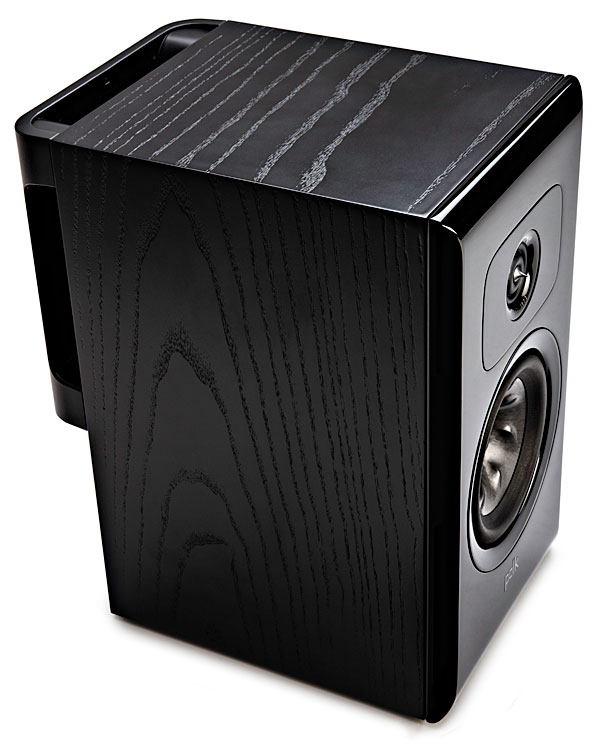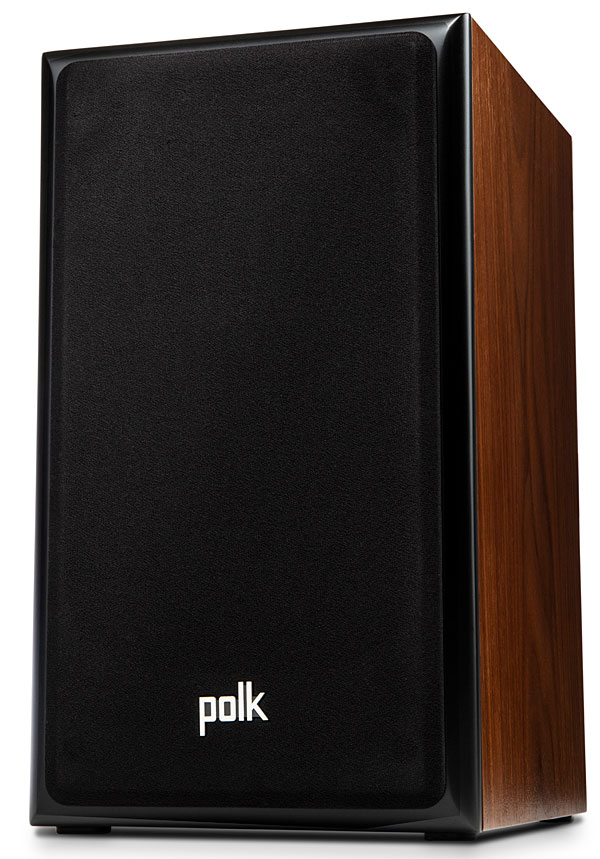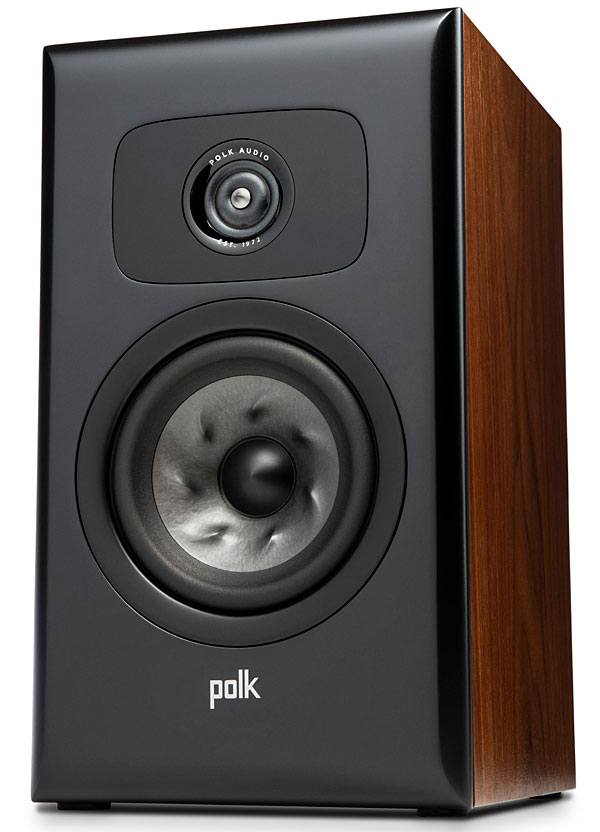| Columns Retired Columns & Blogs |
Great review and once again my bank account is fortunate that my affinity for SE Tube amps limits my speaker choices.
Polk and Mytek
Paydirt came in the form of the Mytek Brooklyn AMP+ (250Wpc into 8 ohms, 400Wpc into 2 ohms, $2495), controlling the volume with the
Mytek Brooklyn DAC+ ($2195). The Polks responded well to the Mytek pair, producing fast, precisely drawn images with good timbre, weight, and texture. Dynamics were first-rate, and the L100s bestowed a coherent, dialed-in sound that caught me up in the drama of every recording.

A good example of the Polk's ability to recreate the feeling of live music came when I spun tenor saxophonist Joe Henderson's In 'N Out (Blue Note BST 84166), recorded in 1964 with trumpeter Kenny Dorham, pianist McCoy Tyner, bassist Richard Davis, and drummer Elvin Jones. This and Henderson's other Blue Note sides are among the cream of the Blue Note crop. Henderson's compositions here are on par with Wayne Shorter's, and each member of the In 'N Out quintet was at a career peak (footnote 2). It's also one of engineer Rudy Van Gelder's finest recordings.
Through the Polk L100s, with the Mytek amplifier, my 1973 repress (dark blue label with black "b") sounded particularly alive, tactile, and punchy. It's known that Rudy Van Gelder boosted upper midrange frequencies,2 but the L100s sometimes pushed upper midrange to treble (of piano, cymbals, reeds, brass) a tad forward, regardless of record or recording engineer. The Polks' emphasis on these frequencies benefitted some instruments, for example making every pluck of Davis's acoustic bass clean and easy to follow; on his solo on "Serenity," his quick left-hand slide from upper to lower neck positions was especially clear and taut.
Low-end warmth from Davis's bass (if not the absolute body) was also present. Good tone, clarity, and extension were steadfast L100 traits. The L100s often fooled me into believing they were replicating bass notes lower than those small mid/bass drivers should allow. The speaker's midrange was reliably distinct and rich-sounding. The soundstage was on the small side although good for such a small speaker. Overall, the L100s reproduced the music of In 'N Out with lots of personality, gusto, and groove.
The L100s can swing. But can they boogie?
On ZZ Top's 1973 breakthrough, Tres Hombres (LP, London Records XPS 631), via the L100s, guitarist Billy Gibbons, bassist Dusty Hill, and drummer Frank Beard practically appeared in my listening room performing a deep cavity frisk of my senses. I've heard other speakers play this record with more weight, depth, and deep-boweled tone, but I've never heard it sound more alive, gritty, and gutsy as it did through the L100s.

On "La Grange," the Polks practically tattooed Gibbons's harmonic-twisting solo on my forehead. They facilitated deep immersion in this Texas-blues-boogie feast. I was transported to the North Carolina nights of my youth cruising country back roads in my friend's Camaro, drinking Boones Farm and passing illegal smokes among my southern brethren.
The L100s' upper mid-to-treble forwardness worked to the music's benefit on Tres Hombres, the speakers' sunlit emphasis supercharging Gibbons's guitar and the stick attack and spread of Frank Beard's ride cymbal. The deepest weight of Hill's electric bass was missing, but there was so much textural energy and transient power emanating from his instrument that I didn't miss that last bit of low-end grunt.
Part of the magic I'm hearing is down to my Kuzma turntable and tonearm and my Hana phono cartridge. But a limited speaker can conceal the finest source. These little Polks didn't. Their fine transparency passed along the detail, punch, and energy the Kuzma combo extracted from recordings.
The Polks acquitted themselves well even with electronic music. On Everything But the Girl's Walking Wounded (LP, Buzzin' Fly Records EBTG010V), Kruder & Dorfmeister's The K&D Sessions (4LP, G-Stone Recordings !K7073LP), and Kraftwerk's Tour De France (4LP, STUMM 310 5099996610916), the L100s dug in, crafting precise images within a wide stereo spread. On deep synth-bass, they had grunt. The AudioTools iPhone app showed that these little speakers were delivering some room-reinforced energy down to 30Hz.
Polk and Cary
The L100s sounded even better with the Cary SLI-80HS integrated amplifier, even in its less-powerful triode mode, where it manages a mere 40Wpc into 8 ohms. The Polks with the Mytek delivered grunt; with the Cary they produced deep, soulful lows. Now, with electronic dance music, the Polks took me to the club, with swelling, physical bass notes. Further up, colors were more saturated. The soundstage was wider and deeper than with the Mytek combo (although images were not as precisely rendered). Images had more flesh, warmth, and weight. The L100s' characteristic upper-mid forwardness wasn't as conspicuous, and the top end was more liquid and richer than it had been with the Myteks.

I can immerse myself in EDM for hours, but I always return to more natural realms of acoustic jazz and classical music. The L100s' transparent-to-lush midrange made acoustic instruments and vocals tangible. I enlisted Ella Fitzgerald's Ella Swings Lightly (LP, Verve MG VS-64021), Melanie de Biasio's A Stomach Is Burning (LP, Igloo IGL193LP), and Mildred Anderson's No More in Life (LP, Prestige Bluesville 1017). The L100s mapped myriad textures in Ella's voice and all of de Biasio's warmth and smoke. Blues belter Anderson was also well served, the L100s framing her coarse, hoarse vocals and Pascal Paulus's stinging Hammond B3 and Steve Houben's tenor sax in high relief. The L100s treated female vocals kindly, especially with the Cary.
The Polks like power, but they seem to like tubes—including the Cary's tubes—even more. It was easy to fall under the Cary/Polk spell.
Compared to the Quad S2
The Quad S2 is a similarly sized, ported, $1000/pair standmount loudspeaker featuring a ribbon tweeter and a 5" Kevlar mid/bass unit. Compared to the L100, the Quad excelled at delicacy and upper-frequency air and presented a slightly deeper soundstage, but it couldn't match the Polk's bass weight or apparent low-end extension, and the Polk's imaging qualities were superior overall. Tonally, the S2 sounded drier. Its soundstage was smaller. The S2 makes fine music but on a smaller scale than the Polk.
Conclusion
The Polk Audio Legend L100 is fun, lively, and dynamic, especially with sufficient power, and especially with tubes. More than once while listening, I uttered "wow," impressed by the scale of the music they presented, such as when Tony Williams unleashed a thunderous drum solo or Ella uttered a vocal phrase with glorious tone and touch. The force and scale of the music it produced, for such a small speaker, its vividness and liveliness and that upper-midrange/lower-treble forwardness were the Polk's defining characteristics. The L100 has a rich midrange, but its low end is its crowning glory, knocking me flat with its surprising apparent extension, warmth, and weight. This may be the most forceful speaker I've encountered of its size.
If you're seeking a compact speaker in this price range that excels in sounding live, that produces surprising bass, and is capable of good dynamics and texture, the Polk Audio L100 deserves an audition.
Footnote 2: "Rudy goosed the upper midrange to make horns, drums, and cymbals sound lively on the systems of the day," Joe Harley, Blue Note's "Tone Poet," told me for an interview published in Jazz Times.

Great review and once again my bank account is fortunate that my affinity for SE Tube amps limits my speaker choices.

Of course, now I need to know more about that L200 and that new KEF LS50!
What a great time for standmounts at humanly kind prices!
Thanks for a killer review that is foundational in its category.

... minimum amount one must pay, today, for a new pair of speakers that are not manufactured in China?
The Dynaudio Emit M10 is made in Denmark and is priced at $799/pr.
Is there anything else that is less expensive?

a person could buy a used pair of Magnapan MG3s w/ribbon tweeter and existing support from the manufacturer.
Just purchased a pair in Miami for under $799.
Are we suggesting that transducer performance has significantly improved over these last 3 or 4 decades? I can't see how it has, in any meaningful way!
What has changed is the cost/price structures and designs featuring lower cost materials. Shipping Costs have skyrocketed mandating designs that optimise shipping & warehouse efficiencies.
China offering labor at 1/10th to 1/20th the Cost of Domestic Labor allows Manufacturers a Quarterly Profit attractive to Venture Capitol.
This Manufacturer's decision makers are selling/diluting their Brand Name for short term gain. ( expect long term pain and low residual dollar values )
Tony in Venice

Focal Chorus 706 (and matching S700 stands).
Cheap and quite great. Made in France! (assembled in France and shipped from France using European MDF for enclosure)
I have them and I can't think of anything comparable for the price. They are of higher build quality than my JBL L890s made in Mexico.
I know that the bottom driver is made in China though but is a Focal exclusive too, not off the shelf. I believe the tweeter is even manufactured in France.

... discontinued models, then we can do even better on price.
The Focal Chorus 605 is still available in new condition for $300 or $349/pr.
https://www.safeandsoundhq.com/collections/focal/products/focal-chorus-605-two-way-bookshelf-speakers-pair
https://upscaleaudio.com/products/focal-chorus-605-bookshelf-loudspeakers-pair
https://www.focal.com/us/high-fidelity-speakers/chorus-600/chorus-605

..assembled in Denmark? Dynaudio is owned by Goertek, a large Chinese company, and does a lot of its driver and cabinet manufacturing in China. Given the cost structures of manufacturing in Scandinavia, I'd bet that the majority (if not all) of the parts for that speaker are sourced out of China, and the rather simple final assembly work is done on a small line in Denmark. The loudspeaker company I worked with in Scandinavia also did this kind of OEM work for a number of well known brands.

... "made in XYZ" label really means "assembled in XYZ from foreign and domestic components".
For example, the British-made Harbeth speakers include tweeters sourced from a company based in Scandinavia and crossover capacitors (other than those for the limited-edition Anniversary models) sourced from a company in Hong Kong.
So, do their speakers deserve to be called "handmade in England", as it states on their website?
In any event, the Dynaudio speakers are labeled "made in Denmark" and the Focal speakers are labeled made in France" - for whatever that may be worth.

Emit
Designed, engineered and assembled in Denmark
Found in both the user guide and the literature.
Where does it say "made"? I always thought that this required that a majority percentage of the individual parts be made in that country. E.g., Made in USA requires at least 50% to my understanding. I'd bet it's at least that high for DK, if not higher.

... the Dynaudio Emit M10 is "Made in Denmark"?
Did it ever occur to you to look on the speaker?
Obviously, not.
https://images-na.ssl-images-amazon.com/images/I/71H2o4tFwFL._AC_SL1500_.jpg
https://www.avprofessionals.in/wp-content/uploads/2020/04/emit_m10_satin_black_back.png

it's Legalese sort of language.
Legal advisors are nudging EVERYONE into the Non-descriptive phrasing of doubt. All except China where there is no doubt that Chinese stuff is made in China, they say it on everything they make. Everyone else hides the china sourcing. ( for dam good reasons: Made in USA equates to 35% better Sales )
The Made in China label signifies the Race to the Bottom.
There are quite a few super high quality Chinese Brands being sold here and globally but they don't have the Glamor Branding of Traditionals like Polk and they don't get reviewed by our better reviewers, Mr. HR the exception.
If Stereophile had a specialist reviewer only reviewing/ reporting on Asian Brands it would be an exciting thing. China has some outstanding gear at Schiit level price points .
Tony in Venice

I asked my local Hifi Specialist to check the labels on the back of his Demo Emit 20s. It says „Made in China“. He also told me that nowadays all cabinets for Dynaudio loudspeakers are manufactured in China, even for the fancier Evoke and Contour loudspeakers.

It's probably great for Wall Street but it's Hell on our Main Street.
It feels like an old friend giving us the middle finger, after all these years.
Tony in Venice

As JA noted ring radiators despite their extended response become beamy.
Therefore I am still with the KEF LS50 and its wide, uniform and Extended response as the
ultimate mini monitor.
Is Stereophile going to look at the new Meta version?

"As JA noted ring radiators despite their extended response become beamy."
I suspect that means they might not be as good for near-field listening, but am not absolutely certain.
These, and the L200s, are getting good reviews. But it seems I'm seeing more reviews for the 100s. Are they considered better?
What happens if you take of the back plate and just let the port fire straight out?
Just a couple of questions.

@dougspeterson:
Yes. Please see John Atkinson's comments at https://www.stereophile.com/content/recommended-components-fall-2020-edition-loudspeakers on September 26, 2020 - 8:29am and on September 28, 2020 - 11:00am.

If Polk has really managed to improve their drivers over their previous series, why couldn't they just offer an improved lsim703, which everyone seems to love? Why do speaker companies always throw away their good old designs? For example, why did Revel go from making the nearly-perfectly-measuring M20 to speakers with smaller cabinets and much less perfect measurements? I don't understand this idea of "progress."

The LSiM series is justly lauded, but nothing sells like a whole new model with new reviews in the audio press. Time will tell if 'this year's model' is actually an improvement or just another lateral move with short-term profits in mind.

It's the same reason Def Tech redesigned their speakers as well, the LSiM had Sandy's name is all over them (LSiM Series). Those and Def Tech Mythos, seem like precursors to the Golden Ear brand. Polk and Def Tech moved away from them. Speaker brands change - sometimes for the better, others for the worse. Some have died because of nostalgia - it didn't look and adhere to the principles of the old stuff even though they measured well (Thiel anyone, happened to Infinity too). That's what happens.

for someone who used a laser vibrometer in the design process to specifically eliminate those resonances(And bragged about it). I would love to hear the designer's take on John's measurements regarding this issue.

I'm more troubled by the port resonance than the cabinet resonance. I'm guessing it's more likely to be audible.

..it's technological resources, the port resonance and cabinet vibrations are pretty interesting observations for a relatively expensive design. Audible or not, it implies some sloppiness in the engineering process. If a company has already invested in the technological resources, it's not the least bit costly to do it right.

Not to pick on Polk in particular (as most first world companies seem to be guilty of this) but it really troubles me (having worked in the UK & US defence industry) that high value intellectual property* is being given to a potential foe. This didn't happen during the Cold War, why is happening now** (was it Nixon in China?), perhaps someone can educate me?
*You may say it's just a loudspeaker but to get to this level requires the same skills that can be applied to other less peaceful devices.
**I fully realize this has been steadily going on for forty years but I've never seen an explanation as to why.

I have the L100s and very much enjoy them with SS. After 30years of SS I want to try tubes and of my 4 speakers sets I want to try the L100s with tubes.
Ken mentions how well the Cary SLI80HS works with the L100s, however, since this will be my entry into tubes I want to try something a little more affordable (<$3000 new). Can anyone suggest FROM EXPERIENCE a tube integrated? Thanks.
Ken - very nice review. Enjoyable read.